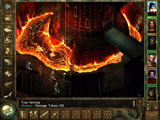 These are heady days for the Advanced Dungeons and Dragons
franchise. After a slump in sales and interest occasioned mostly by TSR’s wretched
stewardship, AD&D was sold to Wizards of the Coast. In the last year or so, good
things have started to happen again. The game’s nifty third edition just came out
(look for a review in these pages soon), and the franchise’s PC presence—nearly
nil since the gold box games—has been reinvigorated by the overwhelming success of
Baldur’s Gate. At least three of this year’s most-anticipated games
(Baldur’s Gate 2, Pool of Radiance, and Neverwinter Nights) are based upon the
AD&D engine. For the first time in a long time, I’m seeing kids at local game
stores playing D&D instead of Pokemon. Looks like the Forgotten Realms are rising to
memory once again. These are heady days for the Advanced Dungeons and Dragons
franchise. After a slump in sales and interest occasioned mostly by TSR’s wretched
stewardship, AD&D was sold to Wizards of the Coast. In the last year or so, good
things have started to happen again. The game’s nifty third edition just came out
(look for a review in these pages soon), and the franchise’s PC presence—nearly
nil since the gold box games—has been reinvigorated by the overwhelming success of
Baldur’s Gate. At least three of this year’s most-anticipated games
(Baldur’s Gate 2, Pool of Radiance, and Neverwinter Nights) are based upon the
AD&D engine. For the first time in a long time, I’m seeing kids at local game
stores playing D&D instead of Pokemon. Looks like the Forgotten Realms are rising to
memory once again. 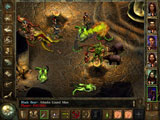 The PC
D&D comeback spearheaded by Baldur’s Gate continues with Icewind Dale. Though
Icewind Dale’s engine and interface are very similar to Baldur’s Gate, there are
some significant differences between the games. First of all, Icewind Dale takes place not
on the balmy Sword Coast, but rather in Icewind Dale, the frigid setting of R.A.
Salvatore’s classic trilogy (though there’s no sign of that popular and
enigmatic dark elf Drizzt). When you’re not fighting in a cave (which is most of the
time) you’ll braving the snowy wastes of the Ten Towns region and the Spine of the
World Mountains. It’s a different world, with a nice new spread of monsters
(including 70 new ones) and environments. Another big difference is the game’s
emphasis on playing as a party, rather than a single player. In Icewind Dale, you’ll
be able to create up six characters for your party when the game begins, and it’s a
good idea to go with all six. Icewind Dale is populated with swarms of monsters, and
smaller parties will quickly be overrun. Believe me, that extra tank will come in handy.
Finally, Icewind Dale allows for higher-level characters.
Though you’ll probably only need to get to level 12 to finish the game, you
can ramp fighters up to around level 15. The PC
D&D comeback spearheaded by Baldur’s Gate continues with Icewind Dale. Though
Icewind Dale’s engine and interface are very similar to Baldur’s Gate, there are
some significant differences between the games. First of all, Icewind Dale takes place not
on the balmy Sword Coast, but rather in Icewind Dale, the frigid setting of R.A.
Salvatore’s classic trilogy (though there’s no sign of that popular and
enigmatic dark elf Drizzt). When you’re not fighting in a cave (which is most of the
time) you’ll braving the snowy wastes of the Ten Towns region and the Spine of the
World Mountains. It’s a different world, with a nice new spread of monsters
(including 70 new ones) and environments. Another big difference is the game’s
emphasis on playing as a party, rather than a single player. In Icewind Dale, you’ll
be able to create up six characters for your party when the game begins, and it’s a
good idea to go with all six. Icewind Dale is populated with swarms of monsters, and
smaller parties will quickly be overrun. Believe me, that extra tank will come in handy.
Finally, Icewind Dale allows for higher-level characters.
Though you’ll probably only need to get to level 12 to finish the game, you
can ramp fighters up to around level 15.
In homage to the recent release of
third edition, I’ve decided to grade out Icewind Dale by converting the standard
abilities used for character generation in AD&D (Strength, Dexterity, Constitution,
Intelligence, Wisdom, and Charisma) to game values. For those of you not familiar with the
system, the highest score possible for each ability is 18, the lowest 3.
STR—18
Strength measures the game’s muscle and physical power; in
other words, is there a lot of action and combat?
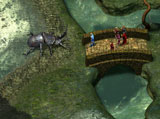 There’s nothing but action and combat in Icewind
Dale. In fact, I’ve never seen quite such an emphasis on hacking and slashing in a
D&D PC game. There’s scarcely such a thing as an empty room in Icewind
Dale—they’re almost all full to the ceiling with monsters. And remember those
leisurely, often uninterrupted strolls you could take across maps in Baldur’s Gate?
Forget it. In some ways, the “monster wave” attacks you’ll experience in
Icewind Dale make the game feel almost more like Diablo II than BG. While this is great for gaining experience, it can
wear down a party in a hurry. Fortunately, it’s very easy to rest in Icewind Dale. If
you’re not in the immediate vicinity of a monster, you can usually get some rest
(which replenishes spells and health) before sallying into the next room. The down side to
this constant fight/rest/fight/rest/fight cycle is that it can get tiresome after a while,
especially since the story is so thin. (More on that later). But if you’ve got that barbarian
mentality—if you find talk cheap and combat the be-all and end-all—then this
game’s for you. There’s nothing but action and combat in Icewind
Dale. In fact, I’ve never seen quite such an emphasis on hacking and slashing in a
D&D PC game. There’s scarcely such a thing as an empty room in Icewind
Dale—they’re almost all full to the ceiling with monsters. And remember those
leisurely, often uninterrupted strolls you could take across maps in Baldur’s Gate?
Forget it. In some ways, the “monster wave” attacks you’ll experience in
Icewind Dale make the game feel almost more like Diablo II than BG. While this is great for gaining experience, it can
wear down a party in a hurry. Fortunately, it’s very easy to rest in Icewind Dale. If
you’re not in the immediate vicinity of a monster, you can usually get some rest
(which replenishes spells and health) before sallying into the next room. The down side to
this constant fight/rest/fight/rest/fight cycle is that it can get tiresome after a while,
especially since the story is so thin. (More on that later). But if you’ve got that barbarian
mentality—if you find talk cheap and combat the be-all and end-all—then this
game’s for you.
DEX—15
Dexterity measures the game’s coordination and agility (i.e., how easy is it to
learn and play, and how slick is the interface?)
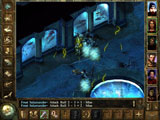 The bad news is that if you’re not familiar with the
AD&D system, Icewind Dale can take a while to get used to. Even if you are, the
interface can be a little arcane and daunting at first. The good news is that once you do
figure it out, this is a very slick interface and game system. It helps that the manual,
like the manual for Baldur’s Gate, is big (150+ pages), detailed, and helpful, though
points must be taken away for its small print on eye-killing gray background. As with
Baldur’s Gate, Bioware’s combat interface is a love-it-or-hate-it-proposition. While ostensibly a real-time combat engine, you
have the ability to pause anytime during a fight and rummage through your backpack for a
new weapon. Since it’s so easy to micromanage, combat tends to play out more like a
turn-based game than a realtime one. This
blurring of genres causes no end of aggravation to some, but I find the engine’s
combination of thoughtful planning and frantic action to be just about perfect. The bad news is that if you’re not familiar with the
AD&D system, Icewind Dale can take a while to get used to. Even if you are, the
interface can be a little arcane and daunting at first. The good news is that once you do
figure it out, this is a very slick interface and game system. It helps that the manual,
like the manual for Baldur’s Gate, is big (150+ pages), detailed, and helpful, though
points must be taken away for its small print on eye-killing gray background. As with
Baldur’s Gate, Bioware’s combat interface is a love-it-or-hate-it-proposition. While ostensibly a real-time combat engine, you
have the ability to pause anytime during a fight and rummage through your backpack for a
new weapon. Since it’s so easy to micromanage, combat tends to play out more like a
turn-based game than a realtime one. This
blurring of genres causes no end of aggravation to some, but I find the engine’s
combination of thoughtful planning and frantic action to be just about perfect.
CON—11
Constitution measures a game’s stamina and endurance. In reviewer terms, this
means replayability.
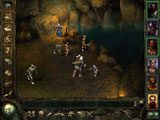 Icewind Dale is considerably shorter than Baldur’s
Gate—but it’s still a good 30-40 hour game for most. Nevertheless, it seems much
more linear than BG, so your options for different game paths are more limited as well.
And while you could play through the game with an entirely different party, let’s
face it: most successful parties are very similar. Oh, sure, you could substitute a druid
here for a mage there, but unless you’re just perverse, you’ll usually have a
nice fighter/cleric/mage/rogue mix. Thus most groups in Icewind Dale play much the same,
and replay value--unless you’re daring enough to recruit a party of nothing but
halfling thieves--is only middling. Icewind Dale is considerably shorter than Baldur’s
Gate—but it’s still a good 30-40 hour game for most. Nevertheless, it seems much
more linear than BG, so your options for different game paths are more limited as well.
And while you could play through the game with an entirely different party, let’s
face it: most successful parties are very similar. Oh, sure, you could substitute a druid
here for a mage there, but unless you’re just perverse, you’ll usually have a
nice fighter/cleric/mage/rogue mix. Thus most groups in Icewind Dale play much the same,
and replay value--unless you’re daring enough to recruit a party of nothing but
halfling thieves--is only middling.
INT—12
Intelligence measures how well the game learns and reasons. In other words, just how
intelligent is the game’s artifical intelligence?
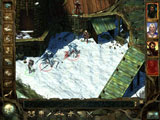 Usually Icewind Dale’s enemy AI is pretty good; close
combat monsters will attempt to get into hand-to-hand while casters stand back and nuke
you. But sometimes they can be pretty stupid. The worst and most ubiquitous example of
this is how easily monsters can be lured one at a time from a room and to their doom. Most players will use this to their advantage,
especially when confronted with one of the nastier rooms in the game. Indeed, it may be
the only way to get past some rooms, where monster numbers are initially overwhelming. But
there’s something dissatisfying about the strategy of luring a few powerful monsters
from a room, dispatching them, resting up, and repeating the above sequence until the room
is nice and shiny. Friendly AI is just
OK--make sure you control all your party members in combat. And as in Baldur’s Gate,
there are still pathfinding problems. For instance, when trying to move your party from
one shop to another in Kuldahar, a few of them will invariably be delayed or hung up.
Don’t try to move across big or complicated maps in one click—often party
members will run off by themselves, become isolated, and stumble across a really nasty
denizen of the North. Usually Icewind Dale’s enemy AI is pretty good; close
combat monsters will attempt to get into hand-to-hand while casters stand back and nuke
you. But sometimes they can be pretty stupid. The worst and most ubiquitous example of
this is how easily monsters can be lured one at a time from a room and to their doom. Most players will use this to their advantage,
especially when confronted with one of the nastier rooms in the game. Indeed, it may be
the only way to get past some rooms, where monster numbers are initially overwhelming. But
there’s something dissatisfying about the strategy of luring a few powerful monsters
from a room, dispatching them, resting up, and repeating the above sequence until the room
is nice and shiny. Friendly AI is just
OK--make sure you control all your party members in combat. And as in Baldur’s Gate,
there are still pathfinding problems. For instance, when trying to move your party from
one shop to another in Kuldahar, a few of them will invariably be delayed or hung up.
Don’t try to move across big or complicated maps in one click—often party
members will run off by themselves, become isolated, and stumble across a really nasty
denizen of the North.
WIS—9 (About
Orc level)
Wisdom measures the game’s perception and insight.
Does one learn any valuable lessons from the game? Does it have any
redeeming aesthetic, social, moral, or intellectual value?
Please. While you could make an argument for a high WIS
score for Black Isle’s Planescape: Torment, which had a compelling and interesting
story, or maybe even Baldur’s Gate, Icewind Dale is about nothing but killin’
monsters. This makes it a lot of things, but
wise is not one of them.
CHA—13
Charisma measures a game’s personality and physical
attractiveness.
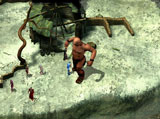 Icewind Dale’s graphics use an improved version of the
Baldur’s Gate engine, but it’s not that improved. While spell effects
look better, the game still runs in 640x480 resolution, and the character sprites can look
very pixelly. The game’s backgrounds, however, look great, as does the interface.
Overall graphic verdict: good, but I sure wish they’d have used the Torment:
Planescape engine. Sound is mostly excellent, especially the music and voice acting for
NPCs. Your party members, on the other hand, endlessly repeat smartass remarks that
weren’t even very witty the first time. This needs some work. Finally, the most
damning thing about the game’s presentation is its narrative, which is lame. The
story throughout the game’s first chapter, for example, is ponderous and advances the
narrative scarcely at all. While things get a little better, it’s clear that the
story here was an afterthought. And there's virtually nothing to match the wit and humor
one found in BG (remember that hamster?) or Torment (remember Morte?). That’s
unfortunate, especially given the strong background that Icewind Dale brings to the table
through Salvatore’s novels. While there are some gestures towards the novels, the
most disappointing thing about the game is its lack of a coherent and compelling story.
Without one, the repetitive hack-and-slash can get boring. Icewind Dale’s graphics use an improved version of the
Baldur’s Gate engine, but it’s not that improved. While spell effects
look better, the game still runs in 640x480 resolution, and the character sprites can look
very pixelly. The game’s backgrounds, however, look great, as does the interface.
Overall graphic verdict: good, but I sure wish they’d have used the Torment:
Planescape engine. Sound is mostly excellent, especially the music and voice acting for
NPCs. Your party members, on the other hand, endlessly repeat smartass remarks that
weren’t even very witty the first time. This needs some work. Finally, the most
damning thing about the game’s presentation is its narrative, which is lame. The
story throughout the game’s first chapter, for example, is ponderous and advances the
narrative scarcely at all. While things get a little better, it’s clear that the
story here was an afterthought. And there's virtually nothing to match the wit and humor
one found in BG (remember that hamster?) or Torment (remember Morte?). That’s
unfortunate, especially given the strong background that Icewind Dale brings to the table
through Salvatore’s novels. While there are some gestures towards the novels, the
most disappointing thing about the game is its lack of a coherent and compelling story.
Without one, the repetitive hack-and-slash can get boring.
Final Call
If you’re into RPGs or D&D,
you’ll definitely want to pick up Icewind Dale, especially if your tastes run towards
unbridled combat. On the other hand, if you’re the type who enjoyed all the talking
in Planescape: Torment, you might want to take a pass.
--Rick Fehrenbacher |

 These are heady days for the Advanced Dungeons and Dragons
franchise. After a slump in sales and interest occasioned mostly by TSR’s wretched
stewardship, AD&D was sold to Wizards of the Coast. In the last year or so, good
things have started to happen again. The game’s nifty third edition just came out
(look for a review in these pages soon), and the franchise’s PC presence—nearly
nil since the gold box games—has been reinvigorated by the overwhelming success of
Baldur’s Gate. At least three of this year’s most-anticipated games
(Baldur’s Gate 2, Pool of Radiance, and Neverwinter Nights) are based upon the
AD&D engine. For the first time in a long time, I’m seeing kids at local game
stores playing D&D instead of Pokemon. Looks like the Forgotten Realms are rising to
memory once again.
These are heady days for the Advanced Dungeons and Dragons
franchise. After a slump in sales and interest occasioned mostly by TSR’s wretched
stewardship, AD&D was sold to Wizards of the Coast. In the last year or so, good
things have started to happen again. The game’s nifty third edition just came out
(look for a review in these pages soon), and the franchise’s PC presence—nearly
nil since the gold box games—has been reinvigorated by the overwhelming success of
Baldur’s Gate. At least three of this year’s most-anticipated games
(Baldur’s Gate 2, Pool of Radiance, and Neverwinter Nights) are based upon the
AD&D engine. For the first time in a long time, I’m seeing kids at local game
stores playing D&D instead of Pokemon. Looks like the Forgotten Realms are rising to
memory once again.